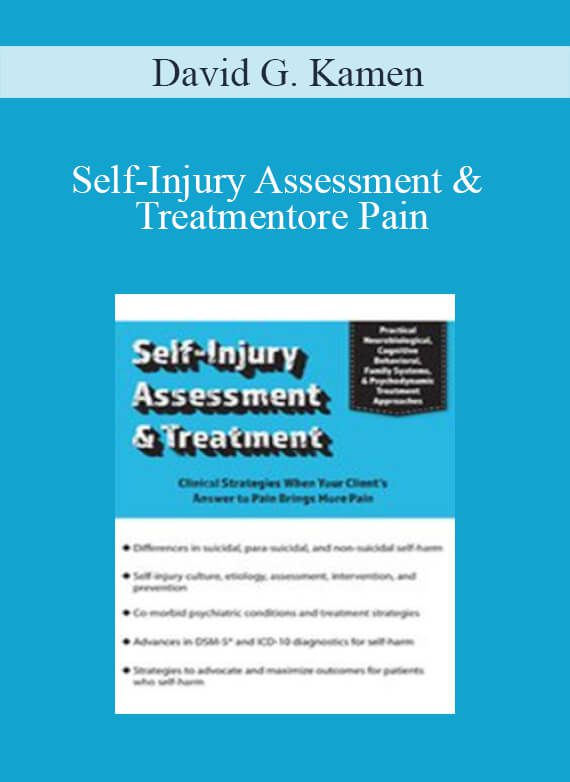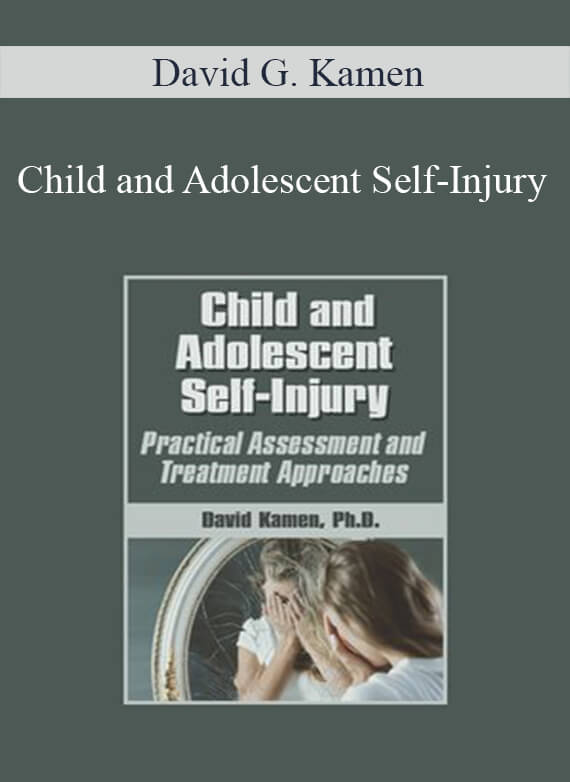[Download Now] Self-Injury Assessment & Treatment: Clinical Strategies When Your Client’s Answer to Pain Brings More Pain – David G. Kamen
$199.00 Original price was: $199.00.$50.00Current price is: $50.00.
[Download Now] Self-Injury Assessment & Treatment: Clinical Strategies When Your Client’s Answer to Pain Brings More Pain – David G. Kamen
Product Delivery: You will receive a download link via your order email immediately
Should you have any question, do not hesitate to contact us: [email protected]
[Download Now] Self-Injury Assessment & Treatment: Clinical Strategies When Your Client’s Answer to Pain Brings More Pain – David G. Kamen
Salepage_https://catalog.pesi.com/item/34425/
Archive: https://archive.fo/wip/QS8eZ
Whether the behavior is cutting, burning, piercing, starving, purging, head banging, or some other method, self-harming behaviors and the emotions underlying them know no bounds with respect to race, ethnicity, age, socioeconomic class, or gender. Feeling shame and embarrassment, those who engage in self-harm may privately console themselves, or befriend other self-injurious peers – which can further intensify the lethality and suicidal intent of their acts. Studies show that professionals who work with adults and youth who self-injure find it to be one of the most challenging psychological issues to treat.
David Kamen, PhD, will equip you with practical, evidence-based tools to assess and treat deliberate self-harm, along with other co-morbid psychiatric disorders including major depressive disorder, obsessive-compulsive disorder, eating disorders, and substance abuse. Effective triage, coordination of care, and risk-management practices for your work with self-injury patients, their parents, families, and friends will be addressed.
The theoretical and cultural reasons for this epidemic will be explored. Practical approaches that work for individual, group, and family psychotherapy in inpatient, outpatient, school, and community settings will be shared, along with resources to prepare professionals and caregivers to help those who engage in self-injury.
- Implement crisis theory for understanding where your client is when you first meet
- Exlore a simple metaphor to create a four part coping measure for client and caregiver self-inventory
- Analyze the benefits of teaching clients to communicate through the use of metaphors to increase their formal and informal support systems
- Establish a listening and communicating approach that brings core feelings to the surface so clients can deal with the core emotional components of their grief
- Communicate the challenges grief has in a society not supportive of public expression of what is being experienced
- Anticipate ethical conflicts that occur when confronted by grief that create a risk for countertransference
SELF-INJURY DIAGNOSIS AND TREATMENT COORDINATION
- Review the spectrum of self-injurious behaviors
- Epidemiology of adult and youth self-injury
- Triage of self-Injury, including:
- Level-of-care assessment
- Lethality risk- and protective-factor assessment
- Functional behavioral analysis of self-injury
- DSM-5® and ICD-10 diagnostic advances
- Mental status examination
- Identification and treatment of co-morbid disorders
- Treatment planning
- Coordination of care amongst mental health professionals, educators, and healthcare professionals
- Specialized clinical personality and art therapy assessment
COGNITIVE-BEHAVIORAL, NEUROBIOLOGICAL, FAMILY SYSTEMS, AND PSYCHODYNAMIC ASSESSMENT AND TREATMENT APPROACHES:
- Motivational interviewing; development of therapeutic alliance
- Exposure with response prevention to extinguish self-injurious behaviors
- Dialectical behavior therapy tactics
- Coping skills to break the habit of self-injury
- Intersubjective and interpersonal therapeutic communication techniques
- The corrective emotional experience and empathic dialogue
- Exposure and resolution of self-injury defense mechanisms
PROFESSIONAL ETHICS, CASE MANAGEMENT, AND LIABILITY RISK MANAGEMENT
- Review of bioethical and legal risk management principles, including
- HIPAA compliance, duty-to-warn issues; ethical and legal dilemmas
- Tips for:
- Professional self-care
- Peer-to-peer collaboration and supervision, to prevent clinician burnout and vicarious traumatization
REVIEW OF PROFESSIONAL, PATIENT, AND CONSUMER-FOCUSED INTERNET RESOURCES AND APPS FOR:
- Self-injury psychoeducation
- Clinical assessment
- Motivational and therapeutic alliance-assessment
- Mental health case law and professional ethics websites
- Self-monitoring of self-injury thoughts, feelings, and behaviors
- Internet resources that are immediately usable for schools, parents, and clients
- Educational and therapeutic use of social networking sites
- YouTube
- Other
Tag: Self-Injury Assessment & Treatment: Clinical Strategies When Your Client’s Answer to Pain Brings More Pain – David G. Kamen Review. Self-Injury Assessment & Treatment: Clinical Strategies When Your Client’s Answer to Pain Brings More Pain – David G. Kamen download. Self-Injury Assessment & Treatment: Clinical Strategies When Your Client’s Answer to Pain Brings More Pain – David G. Kamen discount.
Delivery Method
– After your purchase, you’ll see a View your orders link which goes to the Downloads page. Here, you can download all the files associated with your order.
– Downloads are available once your payment is confirmed, we’ll also send you a download notification email separate from any transaction notification emails you receive from IMC.sale.
– Since it is a digital copy, our suggestion is to download and save it to your hard drive. In case the link is broken for any reason, please contact us and we will resend the new download link.
– If you cannot find the download link, please don’t worry about that. We will update and notify you as soon as possible at 8:00 AM – 8:00 PM (UTC+8).
Thank You For Shopping With Us!
Be the first to review “[Download Now] Self-Injury Assessment & Treatment: Clinical Strategies When Your Client’s Answer to Pain Brings More Pain – David G. Kamen” Cancel reply
Related Products
Medical & Health
Medical & Health
Medical & Health
David G. Kamen – Child and Adolescent Self-Injury: Practical Assessment and Treatment Approaches

![[Download Now] Self-Regulation & Executive Functioning in Children and Adolescents: Visual Strategies and Hands-on Techniques to Provide Structure](https://imc.sale/wp-content/uploads/2022/02/Self-Regulation-Executive-Functioning-in-Children-and-Adolescents-Visual-Strategies-and-Hands-on-Techniques-to-Provide-Structure-Predictability-and-Routines-from-Kathy-Morris-400x556-1-100x100.jpg)
![[Download Now] Self-Harm](https://imc.sale/wp-content/uploads/2022/02/Self-Harm-Suicide-and-Depression-in-the-Schools-–-John-Bearoff-100x100.jpg)
![[Download Now] Self-Injury Assessment & Treatment: Clinical Strategies When Your Client’s Answer to Pain Brings More Pain - David G. Kamen](https://imc.sale/wp-content/uploads/2022/02/Self-Injury-Assessment-Treatment-Clinical-Strategies-When-Your-Clients-Answer-to-Pain-Brings-More-Pain-–-David-G.-Kamen.jpg)
![[Download Now] Child and Adolescent Self-Injury: Practical Assessment and Treatment Approaches - David G. Kamen](https://imc.sale/wp-content/uploads/2022/02/Child-and-Adolescent-Self-Injury-Practical-Assessment-and-Treatment-Approaches-–-David-G.-Kamen.jpg)


![[Download Now] Self-Injury Assessment & Treatment: Clinical Strategies When Your Client’s Answer to Pain Brings More Pain - David G. Kamen](https://imc.sale/wp-content/uploads/2022/02/Self-Injury-Assessment-Treatment-Clinical-Strategies-When-Your-Clients-Answer-to-Pain-Brings-More-Pain-–-David-G.-Kamen-100x100.jpg)
10 reviews for [Download Now] Self-Injury Assessment & Treatment: Clinical Strategies When Your Client’s Answer to Pain Brings More Pain – David G. Kamen
There are no reviews yet.